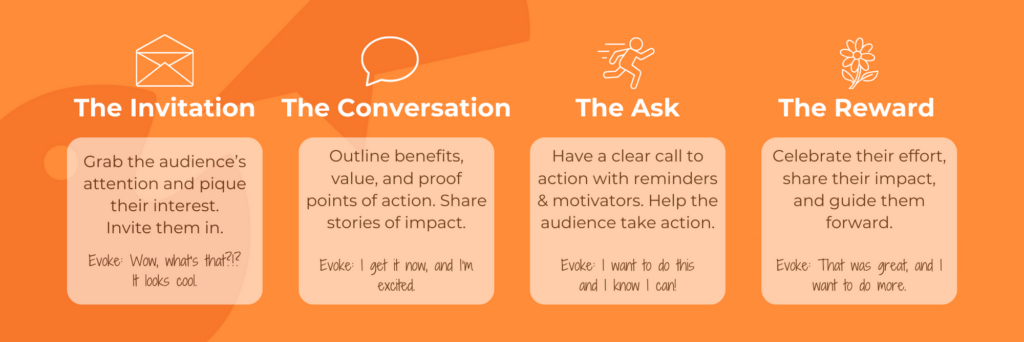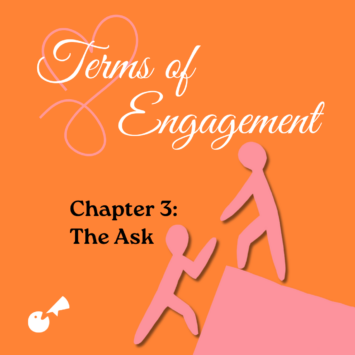
Terms of Engagement: Chapter 3, The Ask.
Terms of Engagement continued.
Welcome back!
In this series, we’re walking through outreach stages where we deepen the connection and engagement with the audience as they continue along their journey of change.
In the previous posts, we covered Chapter 1 on extending an invitation to join our efforts and Chapter 2 on engaging the audience in a deeper conversation. The third chapter focuses on supporting the audience in taking action.
-
Chapter 1: The Invitation.
-
Chapter 2: The Conversation.
-
Chapter 3: The Ask (this post).
-
Chapter 4: The Reward.
Chapter 3: The Ask.
It’s the moment you’ve been waiting for! Let’s get the audience doing things!! Woohoo!!!
The previous stages have led to this moment. Chapter 1 caught their attention and invited the audience to join us. Chapter 2 got them excited about the work we’re doing and how they can get involved.
Now, we help the audience take that first step.
In the AIDA model, this would be a combination of the Desire and Action steps. We increased much of the desire during the Conversation stage, which can lead to the audience taking action.
But, we have to close the intention-action gap. This gap occurs when our knowledge and desires don’t immediately translate into action, often due to various factors (like being busy) that make it challenging to get up and do something.
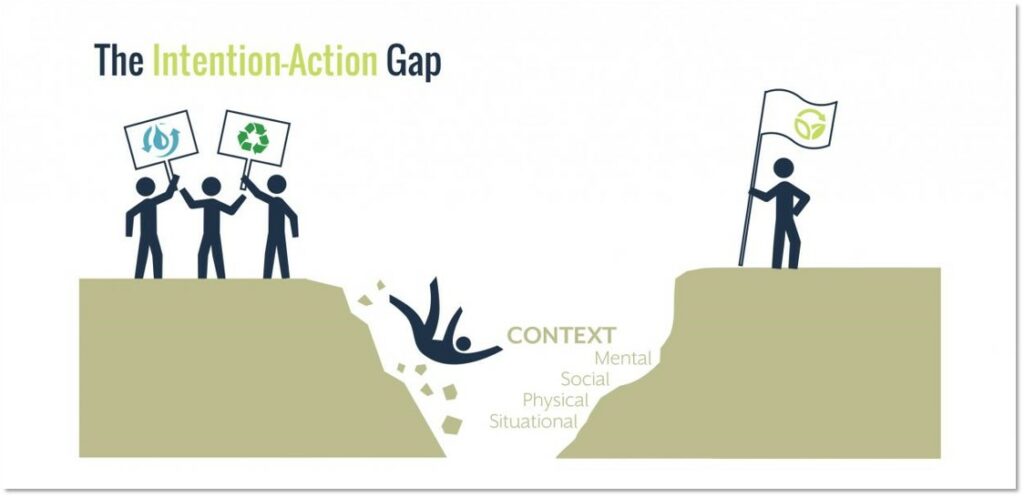
This gap represents a common pitfall for conservation and sustainability projects. We complete the first two stages of engagement and then believe (or, more accurately, hope) our audiences will take it upon themselves to make a change or take action.
A clear and specific call to action that guides the audience in the right direction will help them leap from “I want to do this” to “I am doing it!”
But…
It needs to be more than a clear call to action.
Clarity is critical. But it also isn’t enough.
The Ask stage should include guidance, support, and ongoing motivation to help the audience get started on their journey of change.
Doing this requires an empathetic understanding of the barriers and deterrents preventing action. It also requires us to play more of a guide and coach role in the journey of change.
We can play this role by doing one or more of the following.
Remove friction: The experience of starting something new should be as seamless as possible for the audience. Since many people will feel outside of their comfort zone, they may give up if they encounter hiccups or issues early in the process.
Reduce uncertainty: Map out the details and steps the audience can follow to get started. Don’t place the burden on the audience to figure it out on their own.
Make the action socially safe to do: Showcase the number of people who have already, or are currently, taking action so the audience doesn’t feel alone. Featuring quotes and images of other audience members taking action helps here, too.
Overcome forgetfulness: It’s a busy world, and we all forget to do things – even things we really want to do. Provide a healthy set of reminders in various places to keep the action top-of-mind for the audience.
Reminders and repetition also increase the mere exposure effect, reducing uncertainty and discomfort around change.
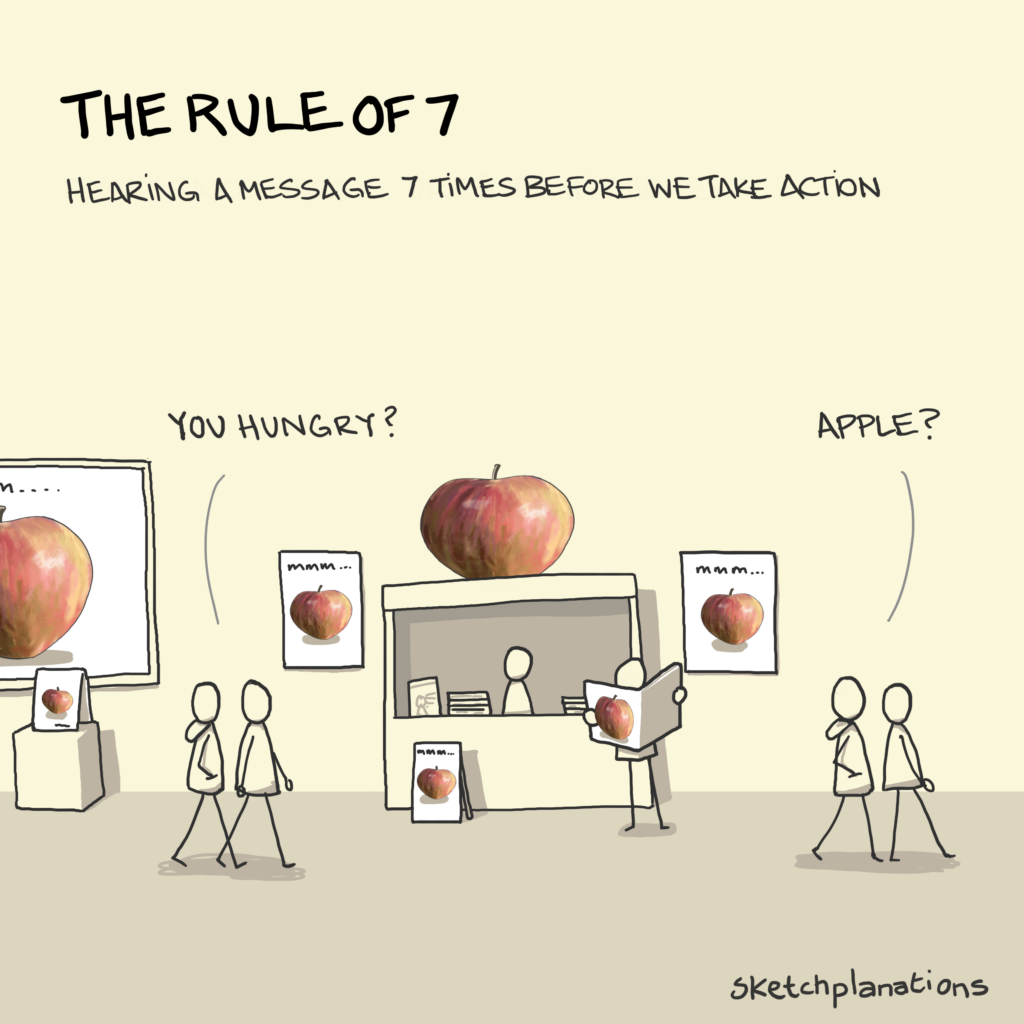
Reinforce the benefits: Even though we’re focused on WHAT the audience should do in this stage, we should still include WHY it’s worth their time and effort. It’s an opportunity to reinforce how the audience benefits personally from taking action and how their individual actions add up to making a bigger impact.
Support and guidance draw more people in because they feel we are on their side. We understand the struggle and want to help.
Where did everyone go?
Your audience at this stage of the engagement process likely looks smaller than when we started with the invitation. While it’s a bummer to see, it’s also natural.
Some depictions of the AIDA model resemble a funnel, similar to the Marketing Funnel or the Sales Funnel. While there are a gabillion iterations of the names and number of stages within these funnels, which I won’t delve into, the purpose of using the inverted triangle shape is to illustrate the loss of audience members along the way.
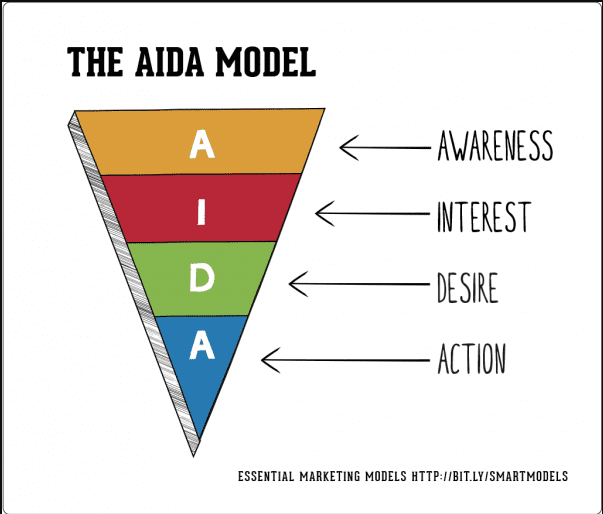
Again, this is totally natural. More people will get excited and interested in your cause than there will be people who follow through on the ask.
Sometimes, this is due to the intention-action gap, but people fall off the journey for many reasons. Keeping our Invitation stage running on a regular basis ensures we continue to engage and re-engage audience members.
Where did you come from?
Another reality to note is that not everyone in your audience will arrive to the Ask stage in the same manner.
Those immediately enthusiastic about your cause may jump right from the Invitation to the Ask, skipping the Conversation stage altogether. This group may circle back to the Conversation stage later to validate their actions, or they will keep moving forward.
Other audience members may take a more conscientious approach by spending a good bit of time in the Conversation stage before moving on to the Ask.
Since your audience will take different paths toward action along different timelines, keeping your outreach efforts running for each stage of the engagement process is essential. This way, you can always meet an audience member wherever they are on the journey.
We’re not done yet! Chapter 4: The Reward is next.



